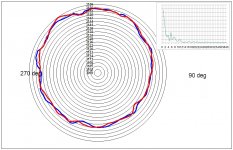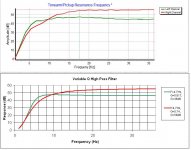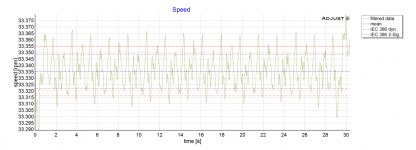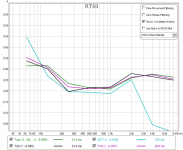Waterfalls. Just compare measurements done close and at the listening position.I don't know how to do a reverb measurement. Pointers would be
helpful.
A few years back, I came across a great method for evaluating FM modulation (pitch modulation) due to low frequency mechanics. Using a 3kHz test tone, 'instantaneous' frequency is plotted against time, but in a circle such that once around the circle is one revolution of the platter.Most of my measurements show a 0.55Hz speed modulation from the record eccentricity and/or the spindle being too small diameter. I thought that this would cause an FM modulation on the signal rather than an AM modulation. So I wonder whether a HP would help with this?
Jan
A picture is worth a thousand words, so I attach a plot from software I wrote for my own use. This clearly shows the major effect of eccentricity on pitch stability. But it is also excellent at showing other sources of pitch stability, including headshell wobble due to cart/arm resonance.
Once round the circle is one platter revolution, radius is measured frequency, each ring represents 0.1% frequency variation. Red and blue traces are two consecutive platter revolutions.
Interesting ?
Attachments
Interesting ?
Yes, can one do Heyser spiral plot with the data?
The author ignores the ESR of the coil on those noise plots, IMO that's why the noise improvement for active termination is less than expected.
Heyser spirals are 3D, with time as the z-axis. My plots are 2D with time represented by rotation around the circle, ie angle, and once around the platter is once around the plot. There is only one variable, which is the radius of the circle, in this case 'instantaneous frequency', the output of a software FM demodulator driven by a 3kHz recorded test tone (3150Hz usually).Yes, can one do Heyser spiral plot with the data?
The data is simply in the form (time, frequency), so I think doesn't lend itself to Heyser plotting which needs time and 2 variables........
\edit: I see what you might mean, have the z-axis as time on a slow sweep so that a 3D record of the pitch stability forms? Interesting !
Last edited:
A few years back, I came across a great method for evaluating FM modulation (pitch modulation) due to low frequency mechanics. Using a 3kHz test tone, 'instantaneous' frequency is plotted against time, but in a circle such that once around the circle is one revolution of the platter.
A picture is worth a thousand words, so I attach a plot from software I wrote for my own use. This clearly shows the major effect of eccentricity on pitch stability. But it is also excellent at showing other sources of pitch stability, including headshell wobble due to cart/arm resonance.
Once round the circle is one platter revolution, radius is measured frequency, each ring represents 0.1% frequency variation. Red and blue traces are two consecutive platter revolutions.
Interesting ?
Yes that's a nice way to represent the data. For long-term drift you probably would have too much overlapping circles to make that of interest, but it's nice for a short-term impression.
The Adjust+ software represents it as the attached. This is filtered with 0.55 Hz.
Jan
Attachments
For the type of FM modulation that Luckythedog just showed can someone give me an idea of how much eccentricity we are talking about here? I never thought much about how far off a center hole could be until all this discussion. Is this thousandths of an inch or hundredths or what? I imagine nobody would ever try and correct this, what would you go by the lead-in groove if you could measure that. Would this fm modulation be equivalent to speed variation on a reel to reel recorder or different because we are talking about a three dimension mechanical system in a turntable.
For the type of FM modulation that Luckythedog just showed can someone give me an idea of how much eccentricity we are talking about here? I never thought much about how far off a center hole could be until all this discussion. Is this thousandths of an inch or hundredths or what? I imagine nobody would ever try and correct this, what would you go by the lead-in groove if you could measure that. Would this fm modulation be equivalent to speed variation on a reel to reel recorder or different because we are talking about a three dimension mechanical system in a turntable.
Yes, tiny offset is all it takes, If center hole is off, or doesn't fit snug to the platter spindle then eccentricity effects occur.
This is something that interests me as it gives the opportunity to measure things that just never used to be possible and actually get a degree of comparative measurement. Actual Proof: SOME Direct Drive turntables do have cogging - Vinyl Engine has some interesting comparisons. Once you have a spectrum-o-crud maybe some of the old chestnuts about 'dark' and 'airy' turntables can be pinpointed to something that can be measured.
For +/- 0.1% pitch variation, an off-centre dimension of about 150um (0.15mm) would suffice. That is +/- 1 ring on my plot, near the threshold of lf pitch variation audibility for most people perhaps.For the type of FM modulation that Luckythedog just showed can someone give me an idea of how much eccentricity we are talking about here? I never thought much about how far off a center hole could be until all this discussion. Is this thousandths of an inch or hundredths or what? I imagine nobody would ever try and correct this, what would you go by the lead-in groove if you could measure that. Would this fm modulation be equivalent to speed variation on a reel to reel recorder or different because we are talking about a three dimension mechanical system in a turntable.
Yes, it's a tiny dimension that is frequently exceeded. Much overlooked and yet another elephant in the room.........
Actual Proof: SOME Direct Drive turntables do have cogging - Vinyl Engine has some interesting comparisons.
Argl !Much overlooked and yet another elephant in the room.........
How could-you listen to vinyl ?
;-)
Esperado,
Purely legacy that is the only reason I would listen to vinyl.I still have albums sitting and a couple of turntables I can use. A Dual and a Technics turntable I have kept all these years, I know I wouldn't go out and buy albums today, to much noise on them, But I will say that I have found so many crappy CD's out there that sometimes I just laugh about the so called perfect sound that was touted in the begining. A scratched CD is probably worse than a scratch on vinyl, at least you can still play the vinly while the CD will just do nothing.
I have had one of my data disk repaired in the past, a copy that Microsoft wouldn't replace so I just paid a couple dollars to have it polished and the disk again worked perfect.
Today it seem that we are moving to strictly a digital source with no spinning media, as long as that isn't a lossy compression that seems to be the way that all music will be purchased and listened to.
Purely legacy that is the only reason I would listen to vinyl.I still have albums sitting and a couple of turntables I can use. A Dual and a Technics turntable I have kept all these years, I know I wouldn't go out and buy albums today, to much noise on them, But I will say that I have found so many crappy CD's out there that sometimes I just laugh about the so called perfect sound that was touted in the begining. A scratched CD is probably worse than a scratch on vinyl, at least you can still play the vinly while the CD will just do nothing.
I have had one of my data disk repaired in the past, a copy that Microsoft wouldn't replace so I just paid a couple dollars to have it polished and the disk again worked perfect.
Today it seem that we are moving to strictly a digital source with no spinning media, as long as that isn't a lossy compression that seems to be the way that all music will be purchased and listened to.
Argl !
How could-you listen to vinyl ?
;-)
Quite easily really. Put vinyl on record player. cue up and go
I'm too scared by all those evils around. Dust, Rumble, Head resonances, wear of the diamond, FM distortion, Tracking distortion, Group delay, Signal noise ratio. Is it really safe ?Quite easily really. Put vinyl on record player. cue up and go
(Smiley here)
For the type of FM modulation that Luckythedog just showed can someone give me an idea of how much eccentricity we are talking about here? I never thought much about how far off a center hole could be until all this discussion. Is this thousandths of an inch or hundredths or what? I imagine nobody would ever try and correct this, what would you go by the lead-in groove if you could measure that. Would this fm modulation be equivalent to speed variation on a reel to reel recorder or different because we are talking about a three dimension mechanical system in a turntable.
In my case it is about 1 mm pk-pk. Which is about 40 thou for the metric-challenged ;-).
Jan
I had one. He used to destroy my vinyls. Not to talk about my cat which sharpened his claws on the covers...Compared to my kids its very safe!
- Status
- Not open for further replies.
- Home
- Member Areas
- The Lounge
- John Curl's Blowtorch preamplifier part II




